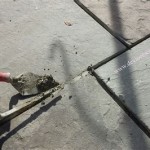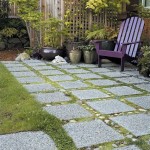How To Lay Patio Blocks On Dirt: A Comprehensive Guide
Creating a patio using patio blocks can significantly enhance outdoor living spaces. Laying patio blocks directly on dirt is a viable option, especially for smaller patios or pathways, offering a cost-effective and relatively simple approach. However, proper preparation and execution are crucial to ensure the patio's stability, longevity, and aesthetic appeal. This article provides a detailed guide on the steps involved in laying patio blocks on dirt.
Understanding the Site and Planning the Patio
Before commencing any physical work, a thorough assessment of the intended patio site is essential. This involves evaluating the soil type, drainage patterns, and existing vegetation. Understanding these factors will inform the necessary preparatory steps and materials required for a successful patio installation.
Soil composition significantly impacts the patio's stability. Clay-rich soils retain water, leading to expansion and contraction that can cause the patio blocks to shift and crack. Sandy soils, while offering good drainage, may lack the necessary compaction for a solid base. Loam, a mixture of sand, silt, and clay, generally provides a more stable foundation. A soil test, readily available from local nurseries or agricultural extension offices, can determine the soil type and guide appropriate amendments, such as adding gravel or organic matter, to improve drainage and compaction.
Drainage is paramount to prevent water from pooling under the patio, which can lead to erosion, block displacement, and potential frost heave in colder climates. Observe the site during and after rainfall to identify areas of water accumulation. Addressing drainage issues beforehand can save significant headaches down the road. This might involve grading the site to ensure a slight slope away from the house, installing a French drain to redirect water, or incorporating a permeable paver system that allows water to permeate through the surface.
Clearing the area of existing vegetation is a critical initial step. Remove grass, weeds, and any other organic matter that could decompose beneath the patio. While a simple weeding might seem sufficient, it's essential to remove the roots as well to prevent regrowth that could compromise the patio's integrity. Using a shovel or garden fork to excavate the vegetation and its root system is recommended. For persistent weeds, consider applying a non-selective herbicide, following the manufacturer's instructions carefully.
Planning the patio's layout is a crucial step. Determine the desired size and shape of the patio, taking into account the surrounding landscape and intended use. Mark the perimeter of the patio using stakes and string, ensuring the lines are straight and the corners are square. This will serve as a guide for excavation and base preparation.
Consider the type and size of patio blocks to be used. Different block sizes will influence the overall layout and the quantity of materials needed. Calculate the number of blocks required based on the patio's square footage, adding approximately 10% extra to account for cuts and breakage. Also, factor in the thickness of the blocks, as this will affect the depth of excavation required.
Finally, familiarize oneself with local building codes and regulations. Some municipalities may require permits for patio construction, particularly if the patio exceeds a certain size or is located close to property lines. Contacting the local building department can ensure compliance and avoid potential fines or delays.
Preparing the Base for Patio Blocks
Creating a stable and well-drained base is the most crucial aspect of laying patio blocks on dirt. A poorly prepared base will inevitably lead to an uneven, unstable patio prone to shifting and sinking. This section details the steps involved in excavating, compacting, and leveling the base material.
Excavation involves removing the soil within the marked perimeter of the patio. The depth of excavation will depend on the thickness of the patio blocks and the desired depth of the base material. A general guideline is to excavate approximately 6-8 inches, including the thickness of the blocks. For example, if the patio blocks are 2 inches thick and a 4-inch base is desired, excavate to a depth of 6 inches.
Use a shovel to remove the soil, working systematically to maintain a consistent depth. A level can be used periodically to check the excavation's flatness. If the soil is particularly compacted, a pickaxe or mattock may be necessary to loosen it. Dispose of the excavated soil responsibly, either by using it elsewhere in the garden or by hauling it away.
Once the excavation is complete, the base material, typically gravel, is added. Crushed gravel, often referred to as road base or base rock, is an excellent choice as it compacts well and provides good drainage. The size of the gravel should range from fine to coarse, allowing for interlocking and stability.
Spread the gravel evenly within the excavated area, using a shovel or rake. Aim for a layer thickness of approximately 4 inches, but this can vary depending on the soil conditions and the intended use of the patio. If the soil is particularly unstable, a thicker base may be necessary.
Compaction is essential to create a solid and stable base. A plate compactor, available for rent from most equipment rental companies, is the most effective tool for this purpose. If a plate compactor is not available, a hand tamper can be used, although it will require significantly more effort. Compact the gravel in layers, adding water periodically to help the gravel bind together. Make multiple passes with the compactor, ensuring the entire area is thoroughly compacted.
After compaction, a layer of leveling sand is added. This layer, typically 1-2 inches thick, provides a smooth and even surface for laying the patio blocks. Use a coarse sand, such as paver sand or construction sand, rather than fine play sand. The coarser sand will provide better drainage and stability.
Spread the leveling sand evenly over the compacted gravel base, using a shovel and rake. A screed board, a long, straight board, is then used to level the sand. Place two pipes or boards on the sand, parallel to each other and spaced a few feet apart. Rest the screed board on the pipes or boards and drag it across the sand, removing excess sand and filling in any low spots. Remove the pipes or boards and fill in the resulting trenches with sand, using the screed board again to ensure a smooth and level surface.
It is imperative to avoid walking on the leveled sand, as this will disrupt the smooth surface and require re-leveling. Work systematically, laying the patio blocks as soon as the sand is leveled in each section.
Installing the Patio Blocks
With the base properly prepared, the process of laying the patio blocks can begin. Accuracy and attention to detail are crucial during this phase to ensure a visually appealing and structurally sound patio. Consistent spacing, proper alignment, and secure setting are key to a successful installation.
Begin laying the patio blocks along one edge of the prepared area, typically against a structure such as a house or wall. Choose the most visually prominent edge as the starting point, as any slight imperfections will be less noticeable along the less visible edges. Use a string line to ensure the first row of blocks is perfectly straight and aligned.
Carefully place each patio block onto the leveled sand bed. Avoid dropping the blocks, as this can disrupt the sand and create unevenness. Gently set each block in place, ensuring it is level and flush with the surrounding blocks. Use a rubber mallet to tap the blocks lightly into the sand, ensuring they are firmly seated.
Maintaining consistent spacing between the patio blocks is essential for both aesthetic appeal and structural integrity. Use spacers, small pieces of wood or plastic, to create uniform gaps. The width of the gaps will depend on the desired look, but a common spacing is between 1/4 and 1/2 inch. Regularly check the spacing with a measuring tape to ensure consistency.
As you lay the patio blocks, periodically check for levelness using a level. Place the level across multiple blocks to ensure they are all at the same height. If a block is too high, gently tap it down with the rubber mallet. If a block is too low, carefully lift it and add a small amount of sand underneath before replacing it.
Cutting patio blocks may be necessary to fit the patio to the desired shape or to accommodate obstacles such as walls or posts. A circular saw with a diamond blade is the most effective tool for cutting patio blocks. Wear safety glasses and a dust mask when cutting blocks, as the process can generate significant dust. Score the block along the desired cut line with the saw, then make multiple shallow passes until the block is completely cut through.
Once all the patio blocks are laid, sweep the entire surface with a broom to remove any debris. Then, fill the gaps between the blocks with polymeric sand. Polymeric sand is a special type of sand that contains additives that bind together when wetted, creating a more stable and weed-resistant joint. Follow the manufacturer's instructions carefully when applying polymeric sand.
Pour the polymeric sand onto the patio surface and sweep it into the gaps between the blocks. Ensure all the gaps are completely filled. Then, use a leaf blower or a soft brush to remove any excess sand from the surface of the blocks. Finally, lightly water the patio with a garden hose, following the manufacturer's instructions. The water will activate the binding agents in the polymeric sand, causing it to harden and create a tight seal between the blocks.

How To Prep Lay A Base For Pavers Western Interlock

How To Lay Patio Pavers On Dirt Jim The Handyman

Diy Booster Learn How To Lay Pavers Like A Pros

Dry Laying Slabs On Gravel Or Sand Instruction Kronos Ceramiche Floor Coverings In Porcelain Stoneware

Diy Pea Gravel Patio With Pavers Love Renovations

Paver Installation Landscaping Network

How To Lay Pavers On Sand Or Dirt Premier Stone

Dry Laying Slabs On Gravel Or Sand Instruction Kronos Ceramiche Floor Coverings In Porcelain Stoneware

Installing Patio Stones 5 Easy Steps Shaw Brick
Dammann S Garden Company Diy Series How To Install Level Pavers And Patio Stones
Related Posts








